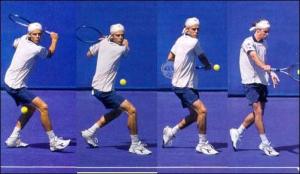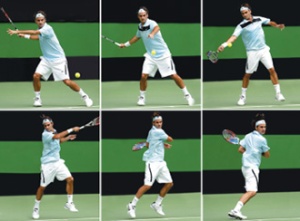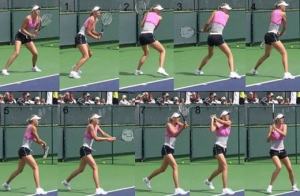Currently there is much debate in professional tennis circles over common ground stroke stances, of which there are 4 variations. Open, closed, semi-open and neutral stance. The most common discrepancy between teaching methods is the open vs closed debate. In the modern game, you don’t need just open or closed, you need to use all 4 stances according to your position on the court and the location of the ball. In this article I will outline each stance with an explanation of when to use it and an image that will serve as an example so you understand the positioning of the feet.
It is important to understand that the upper and lower body move independently of each other. What i mean by that is that the upper body position should remain the same (unit turn and coil) regardless of the stance that you hit the ball in.
Closed Stance:
This stance is most commonly seen on the backhand side in todays professional game, especially on the backhand slice where the shoulders and body must be turned sideways and where forward momentum of the body is needed to step into the ball. On balls that are a little slower and wider, or shorter and wider the player can get sideways and step into the ball to take it early. You will rarely see a closed stance forehand in todays game where total body coiling generates enough pace of shot. A closed stance shot typically takes a little bit longer to recover from, particularly on wider angles. This is where the open stance is used.
(click on the photo to enlarge)
Open Stance:
The open stance is used to great effect on both the mens and women’s tours. One of the reasons this stance is so prevalent in the pro game is because the players are always moving wide! They have to find a way to hit and recover and this is the best option for maximum court coverage. This stance allows you to get to wide balls and recover fast using your outside leg to push back towards the centre of the court after contact. It really eliminates extra steps taken after the shot and so you hold better court position laterally. Use this stance when your opponent pulls you wide with an angle or if you have less time on a wide ball.
(click on the photo to enlarge)
Neutral Stance:
The neutral stance is commonly used on approach shots and balls that require the player to move forward. It allows for total body turn and use of the loading leg (the back one) to maximize getting your body weight into the shot. To hit this ball well you must have good footwork, a nice wide base and use your loading leg to push forward and take the ball early. At the club level most players should use the neutral stance when moving forward to attack the ball. Get your body weight through the shot on your approach and you will have a head start to the net for a put away volley. Especially important to doubles players!
(click on the photo to enlarge)
Semi-Open Stance:
This is the most common stance used at the professional level. Using the semi-open stance the player is able to move to wide balls still use their loading leg to get some forward momentum, uncoil and recover by using their outside leg to push off to the centre and recover. Semi-open stance allows players to load and unload on baseline shots even if they are not attacking the net. It is the most efficient way to hit a big ball and recover. The placement of the feet in this stance are between open and neutral as you can see in the sequence below.
(Click on the photo to enlarge)
* Side note: To maximize your court coverage and footwork make sure you keep a wide base in order to stay balanced react faster to your opponents shot. (Split Step needed!)
Make sure you work with your pro on all aspects of footwork on the court and not just their favorite ones. Developing all your stances and footwork patterns will improve your court positioning and reaction time and will enable you to get the most out of your baseline game.
See you on the courts!
Joel Myers
Tennis Director
Manchester Grand Hyatt San Diego
Sheraton Hotel & Marina San Diego
USPTA Elite Professional
(949) 485-8679





Hi,
Good explanation and examples for the use of different stances.
The approach on low and net height contacts are played in neutral stance, however when the shot is played from the sideline you need a CROSSED STANCE to be able to cover the net position quickly after your shot.
CROSSED STANCE on the deuce sideline is when your right foot is closer to the net then your left foot, so you step in with the right foot…
On the add sideline it’s reversed, you step in with the left foot.
There is no official name for this stance, but that is what I call it 🙂
LikeLike